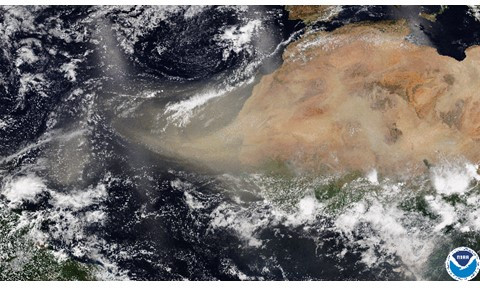
Annually, billions of tons of desert dust move through the atmosphere. The Sahara and Sahel areas of North Africa and the Gobi and Takla Makan regions of Asia are the main sources of transoceanic dust that can have large-scale impacts on human and environmental health through the transport of nutrients, microbes and other particles.
Like giving your garden a dose of Miracle-Gro, nutrients in atmospheric dust — including iron, sodium, calcium, potassium and magnesium — can jumpstart marine microbial bloom growth and change the structure of microbial communities. While this is a vital, pulsed food source for ecologically important diatoms, one concern is that iron-rich Sahara Dust transported into the Gulf of Mexico is linked to the rapid growth of harmful algal species and pathogens.
For example, the pulses of iron can create a favorable environment  for the cyanobacteria Trichodesmium, or sea sawdust, to grow. The Trichodesmium blooms can then provide the “right” suite of nutrients for growth of the dinoflagellate Karenia brevis, which is responsible for red tides in the Gulf of Mexico.
for the cyanobacteria Trichodesmium, or sea sawdust, to grow. The Trichodesmium blooms can then provide the “right” suite of nutrients for growth of the dinoflagellate Karenia brevis, which is responsible for red tides in the Gulf of Mexico.
The atmospheric dust can also carry Vibrio cholera, the causative agent of the severe diarrheal disease cholera, and Vibrio alginolyticus, the bacteria responsible for seawater-associated wound infections.
As climate change continues to have impacts on oceanic and atmospheric circulation patterns, it is increasingly important to understand how the redistribution of airborne nutrients and pathogens will impact human and environmental health and the economy.
GCOOS is at the forefront of national and global efforts to create a Harmful Algal Bloom monitoring network that includes forecasting tools and vulnerability assessments. Using a combination of traditional microscopic cell counts; new technology such as the Imaging FlowCytobot (IFCB) and Optical Phytoplankton Discriminator (i.e. BreveBuster) that yield cell counts in near-real-time; advances in satellite remote sensing data processing; and emerging citizen science programs that are improving spatial and temporal coverage of HAB observations to support models and forecasts, GCOOS and the entire IOOS community are advancing capacity building, technology transfer and joint research efforts to scale up to a global HAB observing system.
Check out these HAB tools:













